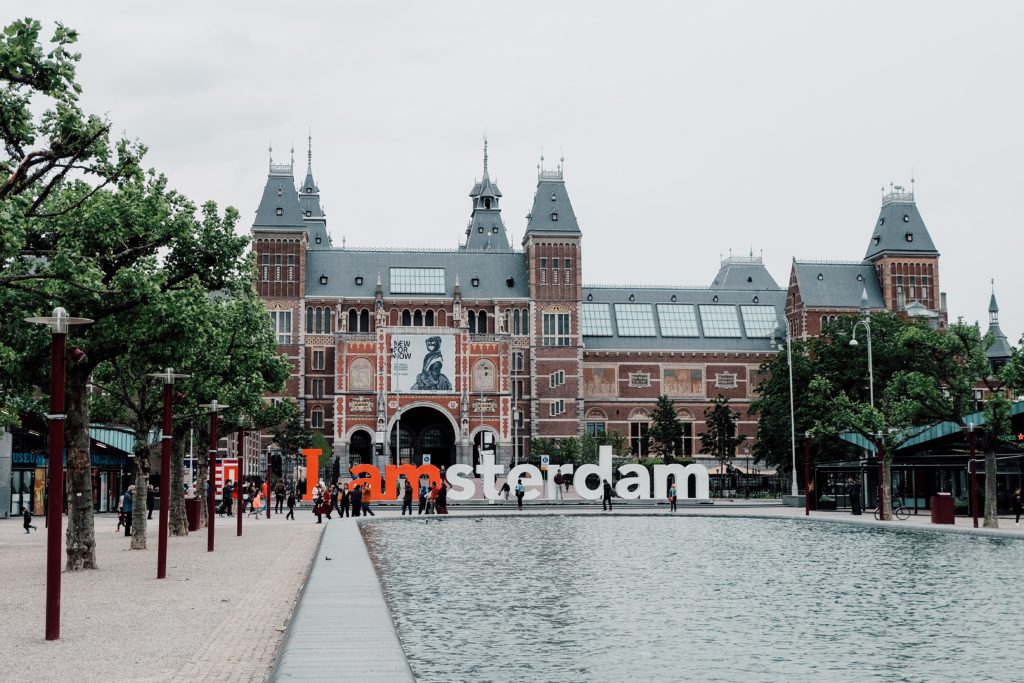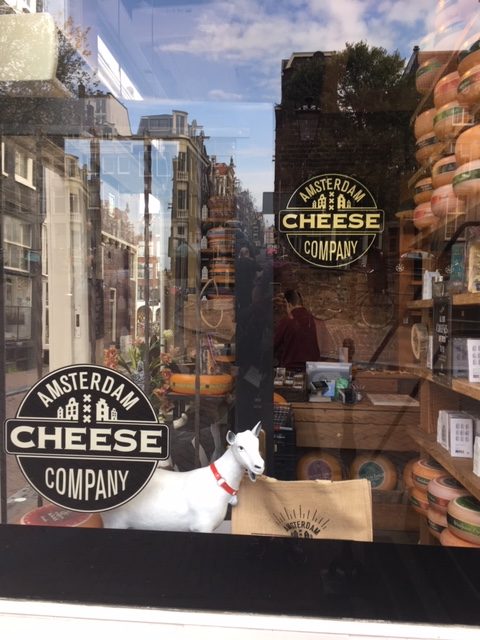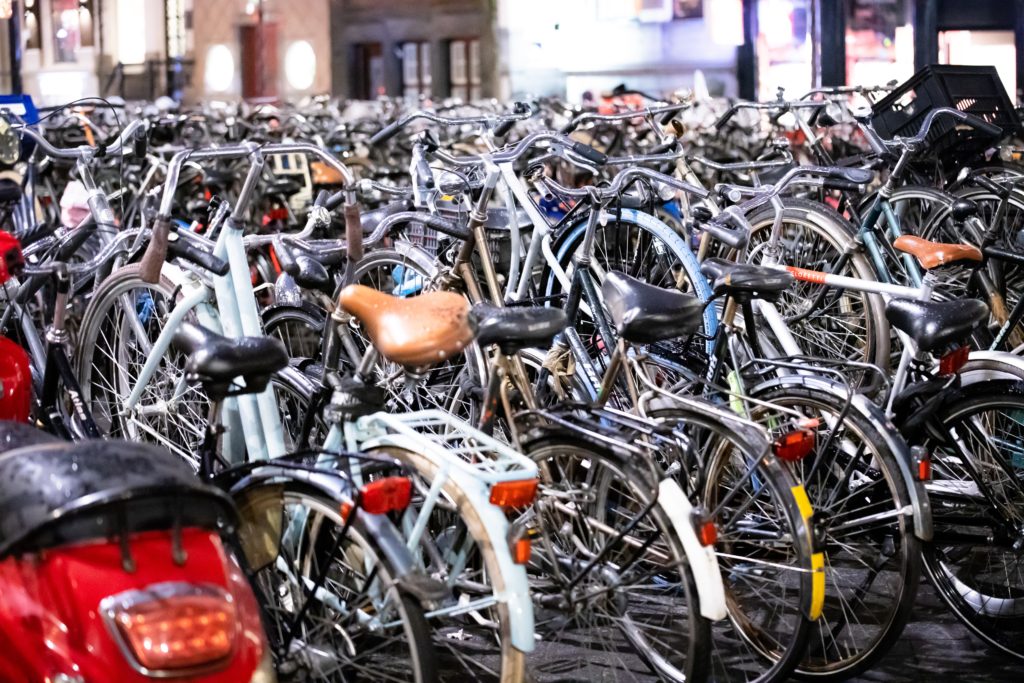This week has flown. It seems just yesterday that I asked Hank to search out art for last week’s essay about the possible demise of the key. (As usually, he found terrific paintings, do you agree?)
 So here I am in Amsterdam, hours away from ending a river tour that began in Budapest and has landed in this Dutch city built on pilings and maintained by unfathomable hydrological control. We are docked with a bevy of other river ships behind the Central Train Station, but, happily, my window is not blocked by an adjacent ship. Instead, I look directly out onto a busy street where, as dusk falls, phalanxes of Amsterdam residents cycle home from work. Surrounding them is a sparkling city, shrouded in heavy history and shaped today by ultra-modern attitudes that are frequently contradictory.
So here I am in Amsterdam, hours away from ending a river tour that began in Budapest and has landed in this Dutch city built on pilings and maintained by unfathomable hydrological control. We are docked with a bevy of other river ships behind the Central Train Station, but, happily, my window is not blocked by an adjacent ship. Instead, I look directly out onto a busy street where, as dusk falls, phalanxes of Amsterdam residents cycle home from work. Surrounding them is a sparkling city, shrouded in heavy history and shaped today by ultra-modern attitudes that are frequently contradictory.
Amsterdam is one of the few places where I cannot imagine myself living. So often I find myself in a European city where the wind whispers, “Stay here, it’s wonderful here, you need to be here!”
 But Amsterdam is not such a city—at least not for me. For starters, the density of population clashes with my American, particularly Texan, sense of wanting to stretch out my arms and own the horizon. Also, despite much glorious river and ocean travel in the past decade, I am not a water person. I enjoy the water’s beauty and particularly like the pale Dutch skies that cover this flat spot of ground lying in part below sea level. Here is a lush land with stunning flowers, amazing cheeses, and a fabulous culinary tradition. Yet, it does not speak to me.
But Amsterdam is not such a city—at least not for me. For starters, the density of population clashes with my American, particularly Texan, sense of wanting to stretch out my arms and own the horizon. Also, despite much glorious river and ocean travel in the past decade, I am not a water person. I enjoy the water’s beauty and particularly like the pale Dutch skies that cover this flat spot of ground lying in part below sea level. Here is a lush land with stunning flowers, amazing cheeses, and a fabulous culinary tradition. Yet, it does not speak to me.
The Dutch do speak, though, cheerily and in a multitudes of languages. Virtually everyone here is bilingual, trilingual, or in possession of four or more languages. You can barely walk ten feet without hearing a change in language. Tourism explains some of that, of course. So does Dutch colonialism. But our city guide boasted of the fact that Holland has recently earned the distinction of having the most nationalities of any place on earth. The figure of 140 different nationalities was offered, and I suspect that’s true.
No, it would not be dull to be here, particularly as a university student. But the romantic whisper to “stay” does not catch my ear. The historic architecture built upon impossible numbers of wooden pilings driven by 17th-century weights dropped by human-driven pulleys may be marvelous to learn about, but it does not move my eye the way the modest half-timbered houses along the Rhine do. The vivid arts scene here, stellar in every way, does not intrigue me like the musical life in the small German city of Bamberg where, after the Second World War, refugees who survived with their limbs intact and instruments in hand came and formed one of Europe’s best orchestras, responsible for transforming the entire city into a first-class arts center.
And for some reasons, the horrors of the Holocaust seem harsher to me in Amsterdam. More vivid, more cruel. Perhaps this feeling arises because of Anne Frank’s poignant place of hiding just down the way—a site so popular that it now requires advance booking if one has any hope of visiting it.
But perhaps it’s the fact that the much-touted history of Dutch tolerance, particularly of the Jewish community, meant little when orders came to empty the ghetto of 80,000 terrified occupants and send them to the Nazi death camps.
Still, time has passed. While the Jewish population never recovered, Amsterdam did. She was spared the total bombing that razed the port city of Rotterdam. Most of what was damaged was replaced, with some historical buildings restored. The city bubbles with energy. Yet it’s no secret that a great deal of that energy is unapologetically hedonistic.
If you doubt that, just stroll around. I’m actually not talking about the Red Light District, which has attained enough mainstream status to be included on most walking tours. I’m referring instead to the proliferation of “Coffee Houses” that are dedicated to every known form of marijuana consumption, despite the drug being technically still illegal. We’re told: “Officials see them, but they don’t see them.” Perhaps some of the best irony comes with the warning signs in the windows of Coffee Houses stating that no alcohol may be consumed inside—“Soft drinks and Soft Drugs only,” they say. At that point, you’ve pretty much stepped through the looking glass.
Yet we’ve had a grand time here. A third of our group went on a bike tour outside of Amsterdam along country paths sprinkled with old windmills. Another third went to the Rijksmuseum, a place loaded with several lifetimes’ worth of Dutch masterpieces for the gazing. I was headed to join the group going to the Rijksmuseum when I was diverted by our ship director and encouraged to join the third route—an itinerary advertised as the Canal Walking Tour.
Momentarily disappointed, I was quickly glad. This route was new to me, and covered more than three miles of small streets and canals. Three miles is a typical distance for a city tour, but passing through Amsterdam this morning felt like negotiating an obstacle course, even with a 9:00 a.m. start.
It happens there’s a major soccer game on the docket this evening, pitting a champion Dutch team (Ajax) with an equally successful English team (Chelsea). The city is filled with English visitors whose presence was detectable already in the early morning. By the time we walked back to the ship at 1:00 p.m., the police were trickling out in force to oversee the high level of pre-game festivity. Friendly rowdiness was in evidence as we passed the plethora of street-side bakeries, cafes, and pubs (beer and Dutch waffles a pre-game specialty, apparently). I had thought about taking a walk after dinner on this, our last evening of the tour, but it’s clear that won’t be the best idea. No matter who wins the match, the atmosphere will be the opposite of what I had in mind when I first envisioned a farewell walk.
 But soccer revelry doesn’t present the biggest challenge to living in Amsterdam. It’s the bicyclers. Our guide said there are 1.5 bicycles for every Amsterdam resident (so about 1.4 million bikes). I’m surprised the number isn’t higher! Bicycles are absolutely everywhere, parked in long columns and filling every space. They have their own recessed, clearly marked, red-bricked lanes, and you’d better not walk in them. There’s a reason they are called “Killer Bikes.”
But soccer revelry doesn’t present the biggest challenge to living in Amsterdam. It’s the bicyclers. Our guide said there are 1.5 bicycles for every Amsterdam resident (so about 1.4 million bikes). I’m surprised the number isn’t higher! Bicycles are absolutely everywhere, parked in long columns and filling every space. They have their own recessed, clearly marked, red-bricked lanes, and you’d better not walk in them. There’s a reason they are called “Killer Bikes.”
Our city guide joked about the three Xs on Amsterdam’s city flag where each “x” symbolizes one of the three historic threats to the city: fire, flood, and plague. Today, though, the interpretation has changed, she said. The greatest dangers in Amsterdam are the killer bikes, the electric trams, and the clouds of cannabis. What would Rembrandt say about that, I wonder?
So we all leave the ship early tomorrow—sadly in most cases, since people tend to become quite connected on such trips. But, then again, you can only eat this well so long. Plus, it’s just time to go. You can feel it.
And new projects await me back home. I will have a better idea of what to tell you once I’ve had a few days to assess things, but I look forward to the chance to announce some of our new horizons.



